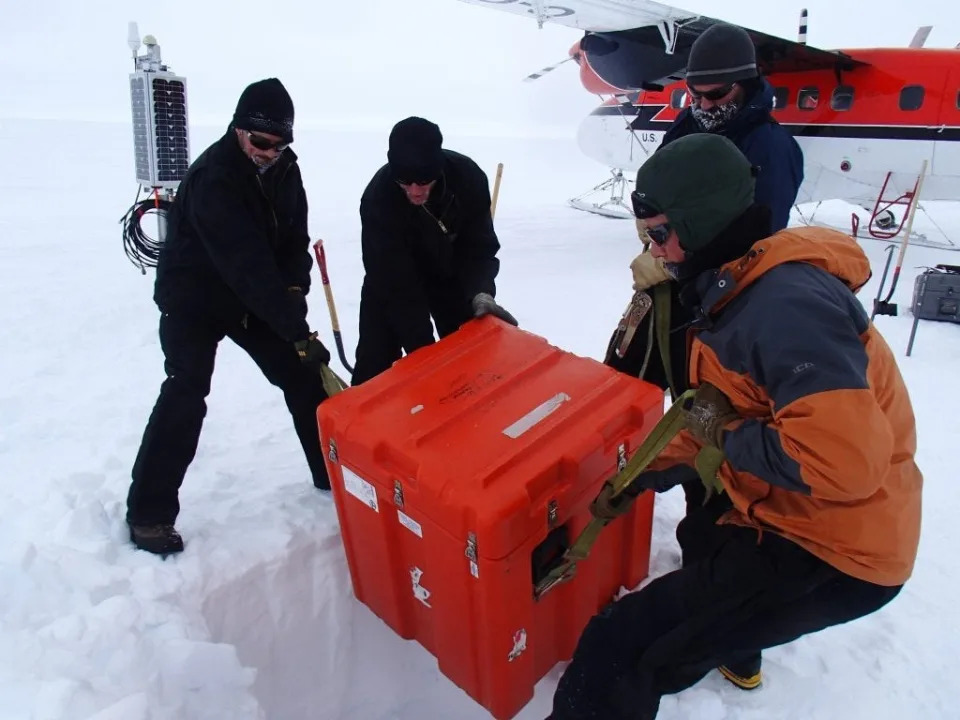Marianne Guenot
Thu, September 14, 2023

An artist's impression inspired by scientists's discovery that a structure, made of ancient ocean, might wrap around the Earth's core, shielding the mantle from its intense heat.Edward Garnero and Mingming Li at Arizona State University
Scientists have created a detailed map of the geology beneath Earth's southern hemisphere.
They believe an ancient ocean floor may be wrapped around our planet's mysterious core.
The new findings could explain why the core is so much hotter than the mantle above it.
There's a lot we still don't know about our planet's core, which lies about 1,800 miles beneath our feet.
Now, a new study has revealed a discovery that could help researchers piece together its mysterious inner workings.
The research suggests that Earth's core could be encased in an ancient ocean floor that features giant mountains five times the size of Mount Everest.
Researchers made the discovery after creating the most detailed map yet of the geology beneath our planet's southern hemisphere.
If confirmed, this "recycled" ocean floor would act almost like a "blanket" that keeps heat trapped inside the core, Samantha Hansen, study lead author and geological sciences professor of the University of Alabama, told Insider in an email.
Earth is like a giant recycling plant
Scientists have long been confused by the boundary between the mantle and the core.
About 2,000 miles under the Earth's surface, conditions shift dramatically: temperatures shoot up drastically, and the rock composition changes abruptly from a solid bulk of rock in the mantle to gooey iron sludge inside the core.
To understand more about this boundary, scientists have looked at seismic waves coming from earthquakes. As these waves spread from the epicenter of the quake through the inside of our planet, they provide information about the Earth's innards.
"Admittedly, to most people, seismic data is probably not that interesting to look at. It is a wiggly line that varies with time. But that wiggly line contains an amazing amount of information!" Hansen told Insider.

Researchers are seen placing their seismic equipment under the snow in Antarctica. Scientists have found looking at data from earthquakes that there may be a layer of ancient ocean floor coating the Earth's core.Lindsey Kenyon
Scientists had previously spotted areas of so-called ultra-low velocity zones (ULVZ) — areas where the seismic waves unexpectedly slow down — near the core-mantle boundary.
But they had only found patches of this unknown structure.
Hansen and her team headed to Antarctica to understand how far that ULVZ could go. They placed seismic equipment at 15 stations on the continent and collected data for three years.
They found the ULVZ was much more widespread than previously thought. Indeed, it was present "over a significant portion of the southern hemisphere," suggesting this layer coats the entirety of the core, said Hansen.
The layer may come from recycled bits of ancient ocean floor
Hansen and her team used modeling to understand how this layer may have appeared.
For them, the answer was clear: the layer was likely bits of ancient ocean floor, gobbled up over the ages from the surface as tectonic plates stretched and squished together.
"As the results came together – both from the seismic work and the geodynamic models – it was quite exciting to see the similarities between them," she said.
"Together, they make a compelling case for subducted oceanic materials being the main source of ULVZs," she said.
Due to its composition, the ocean floor is a perfect candidate for this layer, Hansen said. It's very dense, which means it is heavy enough to sink through the mantle. It's also likely to become more heat resistant as it faces intense pressure deep inside the Earth.
This could explain why the changes seen at the boundary between the core and the mantle are so stark.
"By having this additional layer blanketing the core, the heat won't be able to escape as easily/readily," Hansen said.
It's quite important to understand how heat moves around and escapes the core. The core's temperature variations control "where we have mantle plumes," the pools of lava that create archipelagos like Hawaii, for instance, said Hansen.
It also influences the Earth's magnetic field, she said.
Before we can add this new layer to science books, more research will be needed to rule out other explanations.
Some have suggested that the ULVZ could be due to another, completely unknown, material, generated by the unique chemical reactions that could be happening at the boundary. Others think the bizarre seismic data seen at the boundary is due to a specific state of melting we don't quite understand, said Hansen.
Still, if Hansen's team is correct, this could provide a new chapter to the story of Earth's formation.
"If ULVZs are associated with these subduction materials, they could help us get a better understanding of how the overall plate tectonics cycle works and how our planet has evolved through time," said Hansen.
The findings were published in the peer-reviewed journal Science Advance in April.

No comments:
Post a Comment